I went to see the TE, TOBE YAKI: Tobe Japanese Pottery Exhibition at the 3 Bedfordbury Gallery in London.
Te (手) is Japanese for hand and refers to the fact that Tobeyaki is made and painted by hand. The exhibition was held over three floors.
- Tobeyaki making process and demonstration in the basement
- Tobeyaki master pieces and tableware on the ground floor
- Tobeyaki from the end of the second world war to the present
A wide range of white and blue patterned porcelain pieces and celadon vases were on display. Pictures from the exhibition can be found in the gallery section of the Tobeyaki page.
My wife and I were fortunate to meet Nishioka Hidenori, the director of the committee responsibile for the exhibition and a practicing potter at the Eiryuuji Gama studio. He outlined the history of Tobeyaki and explained more about the making process.
Tobeyaki comes from Eihemi-ken on the island of Shikoku. The area was a prominent source of whetstone (toishi 砥石) principly from Toishi mountain. The original stone looks like this:
The stone is quarried and then refined using a stamp mill. The mill is powered by a water wheel which is connected to the mill shaft. The mill shaft via a number of cogged wheels causes a series of 3-metre-high wooden poles to rise and fall in sequence. The raw stone is mixed with water and passed under the pounding poles. By the end of the refinement process, the stones have been pulverised and the constituent minerals and chemicals mixed with the water to create a rich procelain slip or muddy water (doromizu 泥水). A picture of a working model of this stamp mill, made by Nishioka-san, that was on display at the exhibition is shown below.
The slip is dried and refined to produce a porcelain clay that has a fairly high iron content (testubun 鉄分). Tobeyaki is renowned for indigo blue “gosu” patterns which are applied by hand to bisque pieces. The final colour of the body and pattern vary considerably depending on the temperature of the glaze firing. Test pieces fired between 950C to 1250C are shown below.
A selection of kotobe (old tobetaki 古砥部) shards were also on display. These pieces have informed the production of contemporary tobeyaki and were notably darker in colour than modern porcelains. The knowledgable Nishioka-san explained that this was due to the high content of iron in the original tobe procelain clay and that contemporary clays are refined in a way that removes the clay content.
The tag line for the exhibition, “hidden Gems from a Southern Island of Japan”, proved to be right on the money.
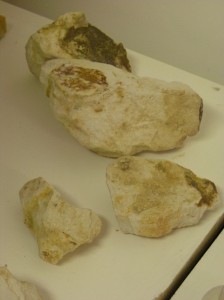
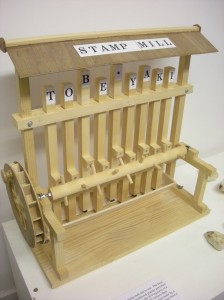

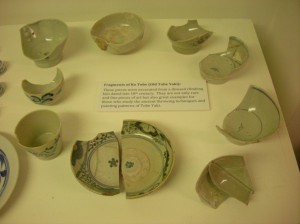
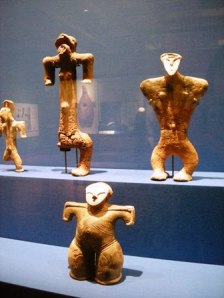 I went along to this exhibition today (in the pouring rain – thanks British weather system) and saw these charming little gingerbread men like neolithic figures.
I went along to this exhibition today (in the pouring rain – thanks British weather system) and saw these charming little gingerbread men like neolithic figures.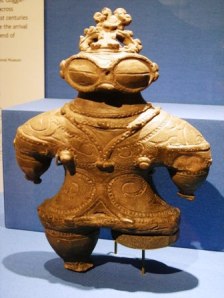 The first figure was found in Kamikuroiwa in Shikoku but they have been found all over Northern Japan; from Honshu to Hokkaido. There’s a clear progression in style from the Early to the Final Jōmon periods. As time passed relatively simple designs made by pressing twisted cords of plant fibres into the clay body prior to firing, were embellished by carving, arabesques, relief patterns and rows of dots. Earlier stiff and stationary dōgu were later shown dancing or holding pots. Some dōgu are integrated into vessels that could be lamps, drums or cooking utensils.
The first figure was found in Kamikuroiwa in Shikoku but they have been found all over Northern Japan; from Honshu to Hokkaido. There’s a clear progression in style from the Early to the Final Jōmon periods. As time passed relatively simple designs made by pressing twisted cords of plant fibres into the clay body prior to firing, were embellished by carving, arabesques, relief patterns and rows of dots. Earlier stiff and stationary dōgu were later shown dancing or holding pots. Some dōgu are integrated into vessels that could be lamps, drums or cooking utensils.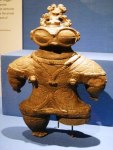
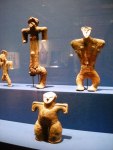
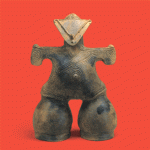
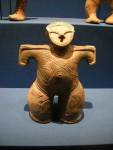
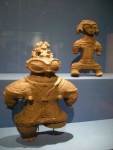
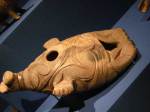
You must be logged in to post a comment.